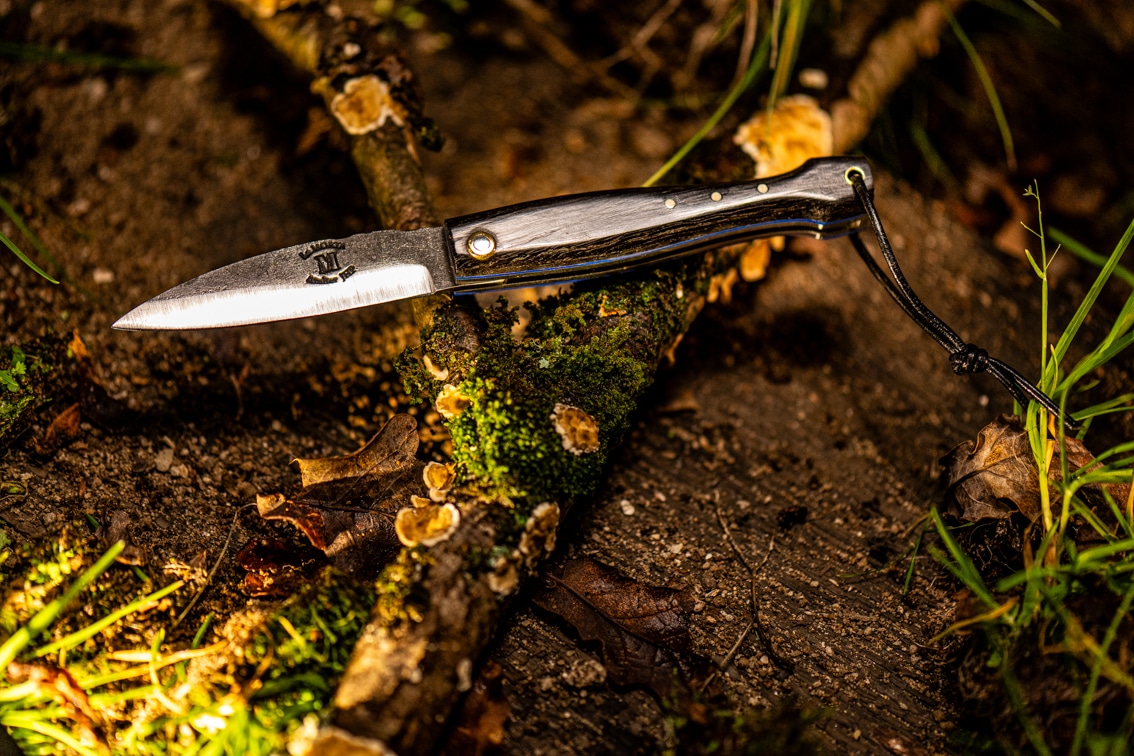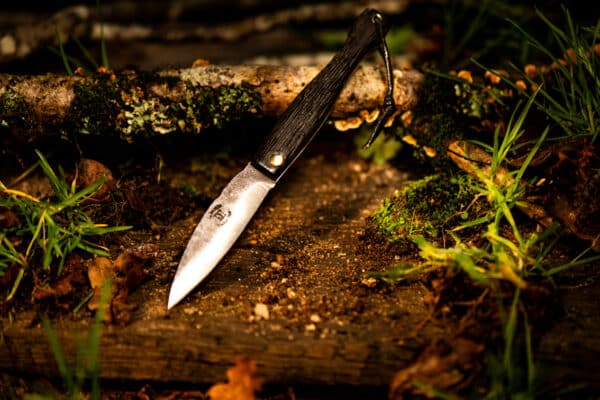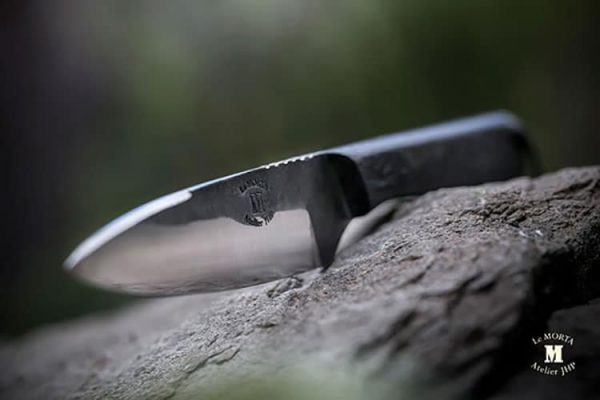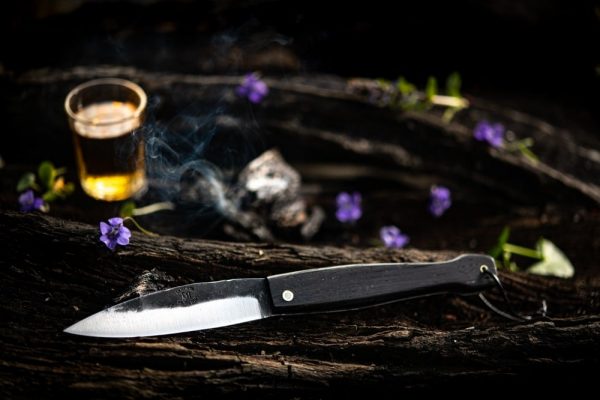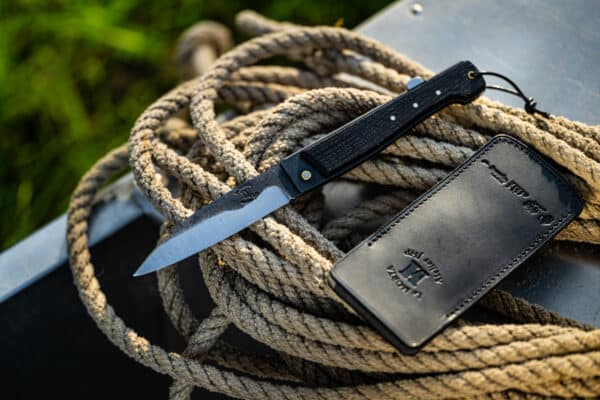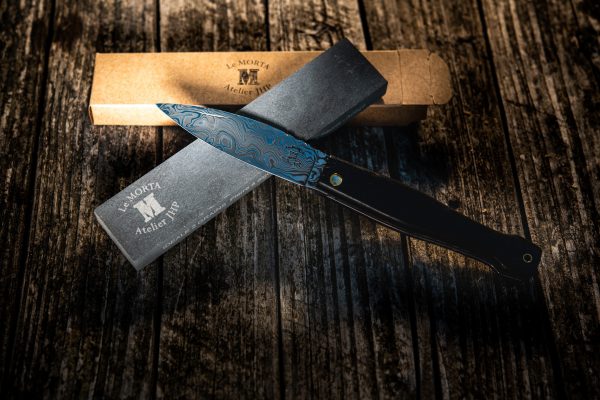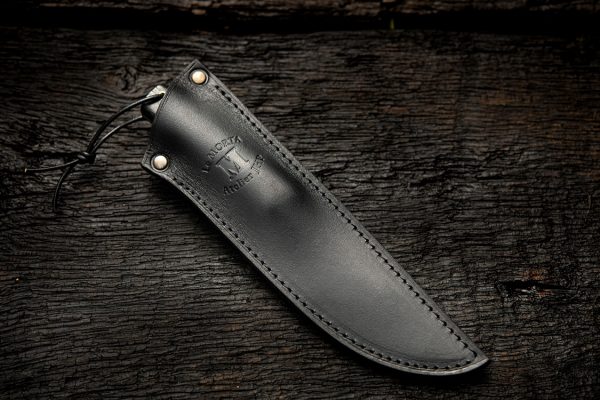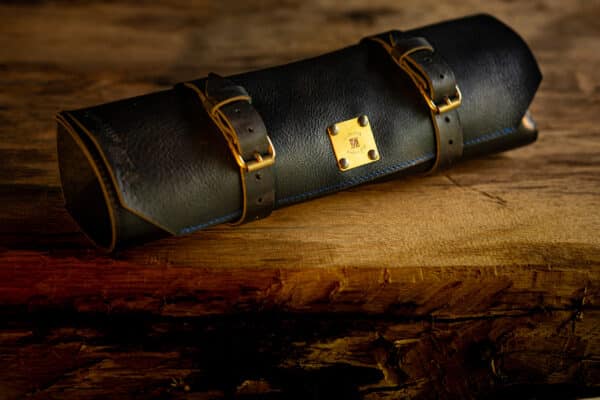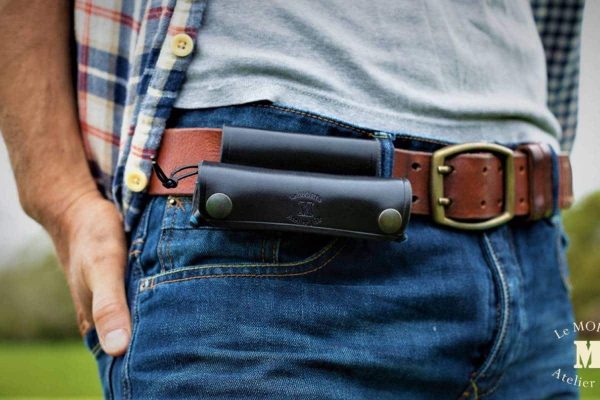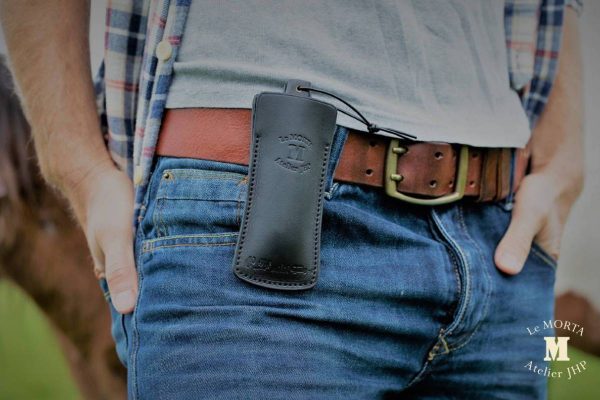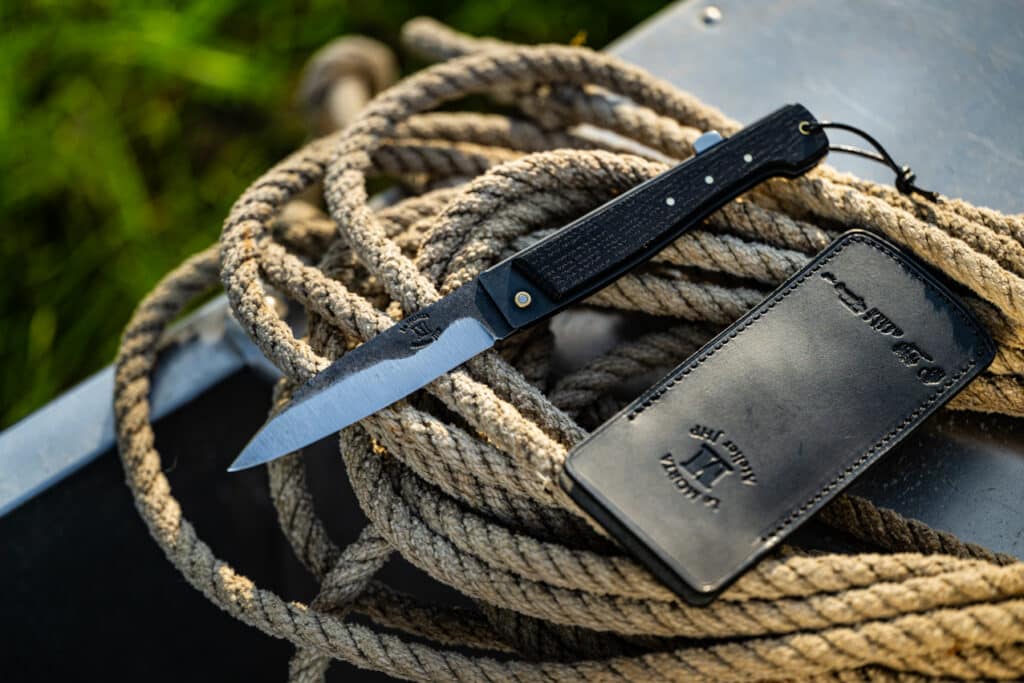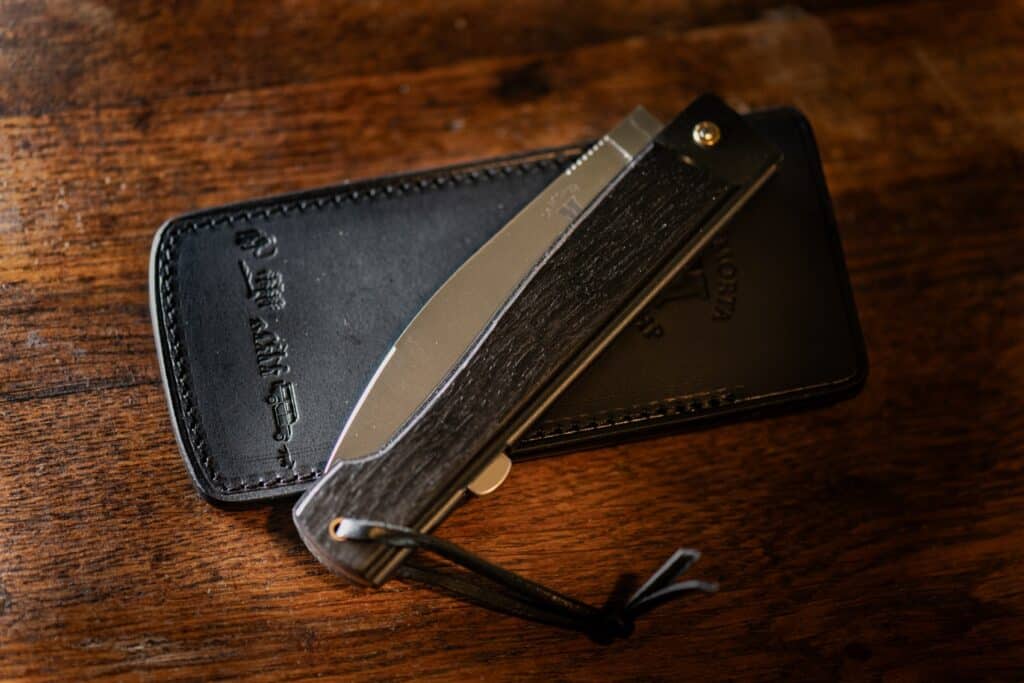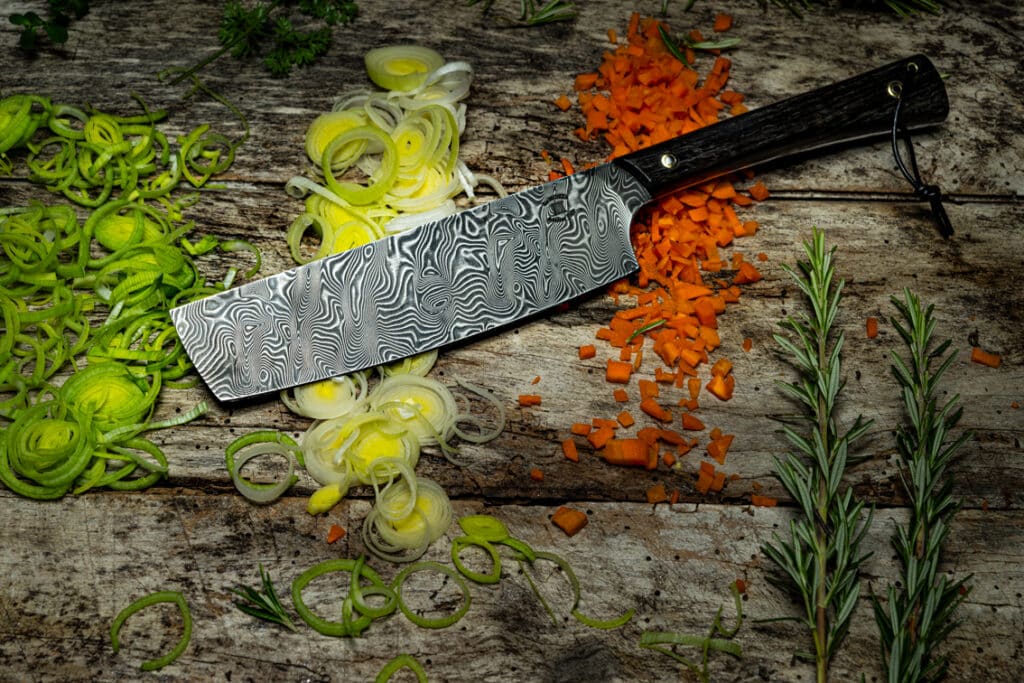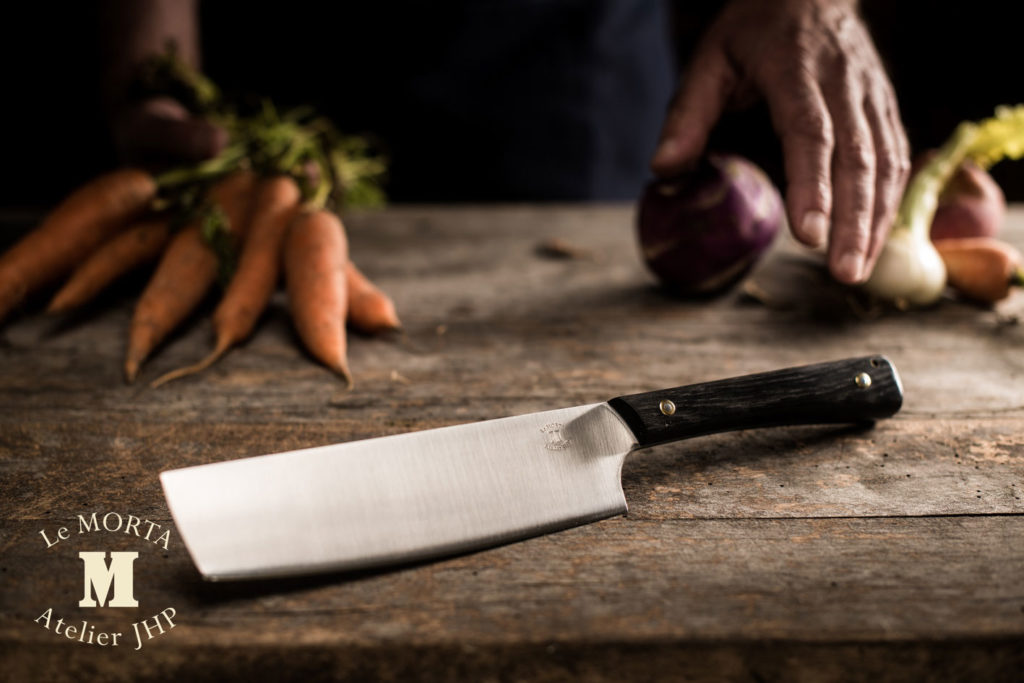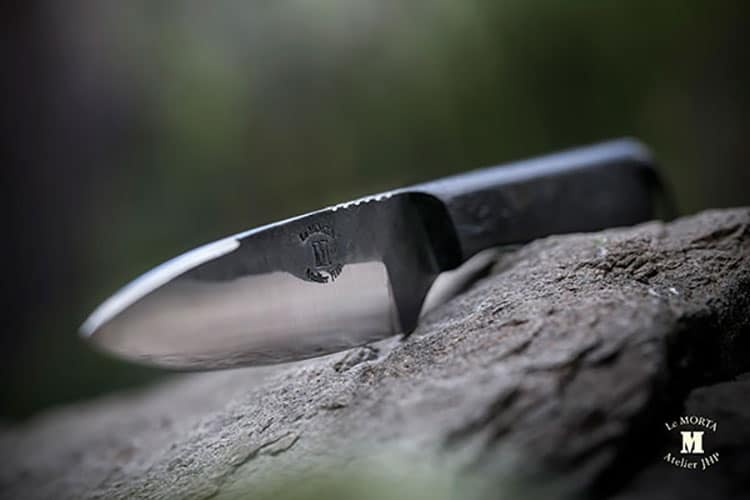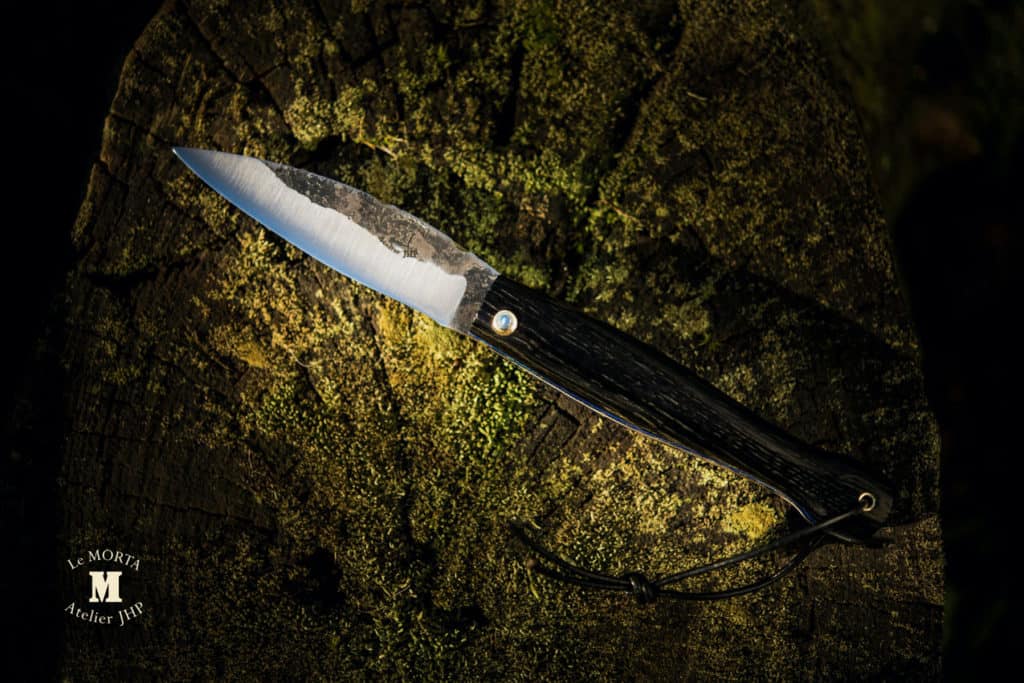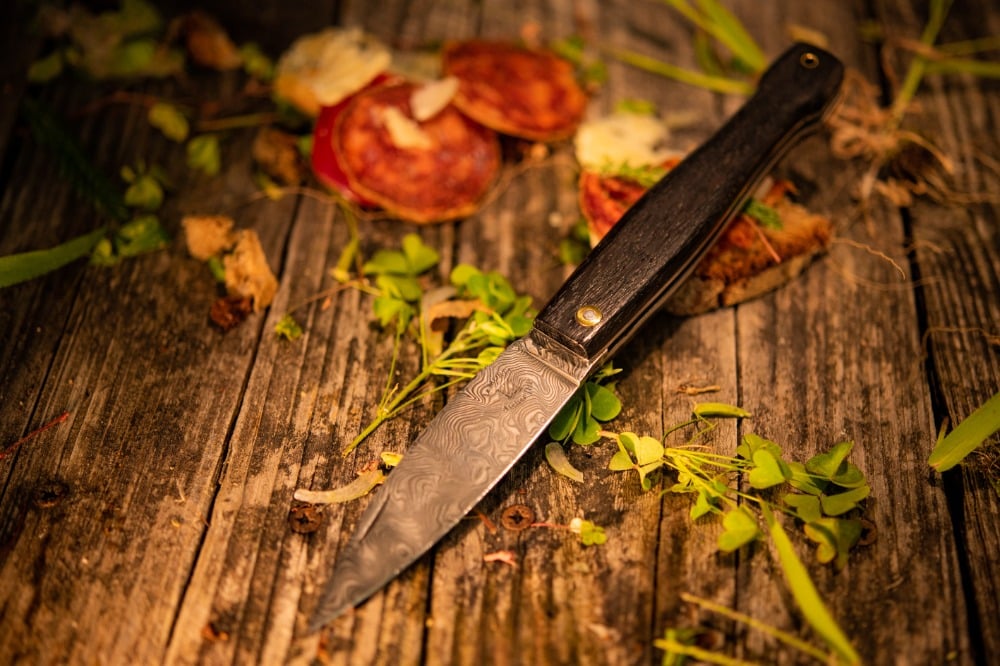90MCV8 steel, also known as O2, is a carbon steel. This alloy combines iron with manganese, silicon, chromium, vanadium, and carbon, resulting in a hardness of 57 to 62 HRC on the Rockwell scale. The balance between its strength and flexibility gives it good resilience, durability, dimensional stability, and forgeability. Knifemakers often use it for outdoor knife blades, appreciating its sharpness. Its dark color provides a contrasting look on a Damascus steel blade. At Couteaux Morta, we understand that steel quality alone doesn’t guarantee blade quality. The difference lies in heat treatment, grinding, and other factors. Each model is crafted from the most suitable metal for the desired qualities. Let’s delve into the characteristics and uses of 90MCV8 steel in cutlery.
The composition of 90mcv8 steel: an alloy suitable for blade manufacture
90 mcv8 steel is a semi-alloyed carbon steel (with moderate proportions of alloying elements).
Chemical composition and impact of elements on the properties of 90cmv8 steel.
- Carbon (chemical symbol C) from 0.80 to 0.95. Carbon increases hardness, wear resistance and tensile strength. In cutlery, it improves cutting quality.
- Silicon (Si) from 0.1 to 0.25. Silicon increases strength and hardness. In metallurgical processes, it acts as a deoxidizer.
- Manganese (Mn) 1.8. Manganese enhances surface hardness, facilitates hammering and resistance to impact and stress in general.
- Chromium (Cr) 0.2 to 0.35. Chromium increases resistance to corrosion (rust), as well as toughness, wear resistance and tensile strength. A minimum of 13% chromium makes the steel stainless. Steel 90 mcv8 is not stainless.
- Vanadium (V) from 0.05 to 0.2. Vanadium improves steel’s corrosion resistance and toughness. It also refines the grain.
Exact ratios vary from one fabricator to another.
90mcv8 steel meets AFNOR 90MCV8, DIN 90MnCrV8, Wnr 1.2842 and AISI O2 standards.
Among the big-name metalworkers who offer 90mcv8 steel: Abrams.
The advantages of 90mcv8 steel for cutlery
Hardness
Resistance to impact and wear is determined by hardness, measured on the Rockwell scale.
Each sector of activity has its own constraints and requirements.
In cutlery, we consider :
- 54 to 56 HRC minimum for a standard knife blade ;
- 56 to 58 HRC for professional knives (kitchen knives, chef’s knives) ;
- over 58 HRC for knives that combine a good cutting edge with comfortable sharpening.
🔪 At Couteaux Morta, no blade is offered below 59 HRC. In fact, the strength, robustness and quality we want to present to you require this value threshold.
🔪 Our rough-hewn blades made from 90mcv8 steel offer a hardness of 59 to 60 HRC.
-

Mini solid morta as forged
210,00 € This product has multiple variants. The options may be chosen on the product page -

Compact fixed knife as forged
180,00 € This product has multiple variants. The options may be chosen on the product page -

XL Solid Morta as forged
325,00 € This product has multiple variants. The options may be chosen on the product page
Sharpening for optimum cutting performance
The harder a blade is, the harder it is to sharpen, but the better it holds a cut. The durability of the cutting edge also depends on how regularly you sharpen it.
For more information and tips, see the video at the end of this article 👇.
Heat treatment: forging
The forging stage (heat treatment) is essential for good quality steel, whether it’s 90mcv8 or any other alloy. It determines the steel’s hardness, but also its suppleness, to enable the cutler to work with it (in the case of a knife blade, for example).
This begins with annealing at a temperature of between 850 and 1050°C. The steel is then cooled very slowly in a tempering furnace at a controlled temperature (810°C). The quenching medium must contain oil (temperature 790-820°C).
Compliance with this heat treatment results in a hardness of up to 62 HRC.
Good to know 😉
➡️ Hardening increases the hardness of the metal’s surface layers.
➡️ Annealing, on the other hand, reduces hardness, but increases ductility and facilitates the removal of internal stresses from the steel. Ductility is the ability of steel to deform before breaking, also known as yield strength.
At Couteaux Morta, forging is carried out in our Saint-André des Eaux workshop in Loire-Atlantique. Drop in for a visit, and we’ll explain it all to you in person.
Other industrial applications for O2 steel
The quality and strength of O2 steel make it ideal for industrial applications. In particular, it is used for :
- cutting tools (up to 6 mm sheet thickness) ;
- shear blades
- comb threading tools;
- mandrels for threading dies ;
- reamers ;
- measuring tools ;
- molds for plastics, rubber ;
- gauges ;
- guide bars ;
- dies ;
- punches ;
- woodworking tools ;
- machine blades, such as a circular blade in the paper industry,
- etc.
Which knife blades come from 90mcv8 steel?
Outdoor knives
90mcv8 steel’s shock resistance and hardness make it ideal for the manufacture of sturdy knife blades. Hunting and hiking knives in particular, but also all knives used outdoors.
You’ll find this alloy on certain folding knives, such as one of the latest Morta Knives models, the brut de forge rear-pump pocket knife.
Forged in the workshop, it stands out for its tempered steel character. Its hardness of 59/60 HRC offers exceptional sharpness.
Good to know 😉
🔪 The back pump knife can be customized:
- text engraving with choice of font ;
- mammoth ivory inlays.
Some cutlers use 90mcv8 steel to create Damascus blades. Its dark color creates a high-contrast moiré effect. At Couteaux Morta, Damascus comes from RWL34 – PMC27 steel, with a hardness equivalent to 90mcv8 (59 HRC).
Forged steels
At Couteaux Morta, the blades of our rough forged models are made of 90mcv8 steel for their excellent cutting edge and ease of sharpening. They are hot-forged before tempering.
How do I maintain a 90mcv8 steel blade?
Sharpening
Several sharpening methods are available:
- stone, preferably natural, which resharpens the edge of the blade;
- the rifle, which straightens the blade edge and maintains the cutting edge without the need for stone sharpening;
- the ceramic rod, which offers the same benefits as the shotgun;
- the hope of an infinite cutting edge, but no, no way 😅!
Jean-Henri, our cutler, recommends sharpening on a natural stone. He recommends finding the method most comfortable for you (stone in hand, on a support, pulling or pushing the edge of the blade).
In all cases :
- moisten the stone thoroughly, as water and steel films form an abrasive paste that restores the blade’s sharpness;
- place your stone on a cloth or paper towel for more precise work;
- position the blade at an angle of 15° to 25° to the stone;
- evenly, without pressure, from the base to the tip of the blade;
- on one side, then the other (as many times on each), using an even, regular gesture;
- Finally, to remove the small teeth formed on the edge of the blade during sharpening (the morfil), you can
- make two passes while pulling the wire, or
- use barber leather and polishing paste.
Your cutler recommends:
🔪 that it’s always the same person (you) who sharpens the knife, because naturally, you always keep the same angle ;
🔪 that it’s always the same person (you) who sharpens the knife, because naturally, you always keep the same angle ;
🔪 sharpen your blade regularly, without waiting for it to stop cutting.
In this way, you gain in habit, improve your craftsmanship and enjoy the benefits of a sharp edge at all times 💪.
A picture is worth a thousand words, the method on video 👇
Our natural sharpening stones are made in Saurat in the Ariège region of France. Hey, made in France, yes or no?
Cleaning
As this steel is not rustproof, it must be thoroughly dried before storage. Don’t hesitate to lubricate it regularly with the fat of a sausage freshly sacrificed on the altar of the aperitif.
Storage
Your fixed knives should be stored in a drawer away from distracted fingers, light and humidity. For added security, the sheaths offer protection both inside and out.
The storage case holds 3 knives, and is available with blue or black stitching, depending on your choice.
For your pocket knives, cases and sheaths for folding knives. Topstitching is also available in blue or black. Which do you prefer?
Other steels used in cutlery
Damascus steel
Knife aficionados will be familiar with the famous Damascus steel and its moiré sheen. The result of powder metallurgy, it combines the beauty of a work of art with the quality of a steel. The RWL34 – PMC27 steel of which it is made has a hardness of 59 HRC.
The proof is in our Damascus collection.
Stainless steel
Its main quality lies in its name. Stainless, it offers optimum resistance to corrosion. Cooks (chef’s knives, table knives) and outdoor tradesmen appreciate it because it doesn’t rust.
Hardness 59 HRC. You don’t change a winning team.
14c28n steel
This stainless alloy contains 14.5% carbon for a hardness of 59 HRC. It ensures perfect hygiene. It is also appreciated in damp, salty environments (fishing, hunting, hiking, gathering). At Couteaux Morta, 14c28n steel opens oysters. We also like it for a particular model of pocket knife: the Morta with rear pump.
In short, 90mcv8 steel has all the qualities needed to make a good knife blade. However, a good knifemaker doesn’t stop at its properties when choosing it. All the work that follows and the care you devote to it will make all the difference.
Article written by Christelle Lorant 🪶.
Article summary
What properties characterize 90mcv8 steel and its use in cutlery?
90mcv8 steel is a semi-alloyed carbon steel that combines carbon with elements such as manganese, silicon, chromium and vanadium.
These elements give the alloy a measurable hardness of 57 to 62 HRC on the Rockwell scale, ensuring a balance between impact resistance and cutting capacity.
This steel is commonly used in the manufacture of hunting knife blades due to its strength and sharpness, making it particularly suited to harsh outdoor conditions.
How does heat treatment improve the qualities of 90mcv8 steel for cutlery applications?
Heat treatment of 90mcv8 steel is essential to obtain its optimum mechanical properties. This process begins with annealing at temperatures ranging from 850 to 1050°C, followed by very slow cooling to reduce internal stresses.
Final quenching in oil at a controlled temperature of 790 to 820°C maximizes hardness while maintaining good ductility.
This rigorous heat treatment makes the steel suitable for cold working, often used for the manufacture of traditional steel blades offering high impact resistance and dimensional stability.
What are the other industrial uses for 90mcv8 steel apart from cutlery?
In addition to cutlery, 90mcv8 steel is used in the manufacture of cutting tools, shear blades and comb threading tools up to 6 mm sheet thickness.
It is also used in the production of reamers, dies, punches and measuring tools, thanks to its hardness and resistance to wear.
Its composition enables it to be used for applications requiring a precise surface finish and resistance to high mechanical stress.
What are the maintenance recommendations for a 90mcv8 steel blade to maintain its optimum cutting edge?
To maintain the quality and sharpness of a 90mcv8 steel blade, we recommend regular sharpening with a natural stone, maintaining an angle of 15 to 25 degrees for effective sharpening.
In addition, it’s important to keep the stone well moistened to create an abrasive paste that helps sharpen the edge of the blade.
After sharpening, you can use a barber’s leather with polishing paste to finish the edge and remove any residual roughness. Store the blade in a clean, dry case to protect the metal from corrosion, especially as this steel is not stainless.
What makes this steel suitable for creating Damascus blades?
90mcv8 steel is generally chosen for Damascus blades because of its very dark color, which creates a particularly high contrast with other steels in the Damascus pattern.
This contrast accentuates the aesthetic beauty of the blades while maintaining superior strength and sharpness. As a result, the finish achieved with this steel in Damascus blades is visually appealing as well as functionally superior, thanks to the hardness and wear resistance of 90mcv8 steel.


